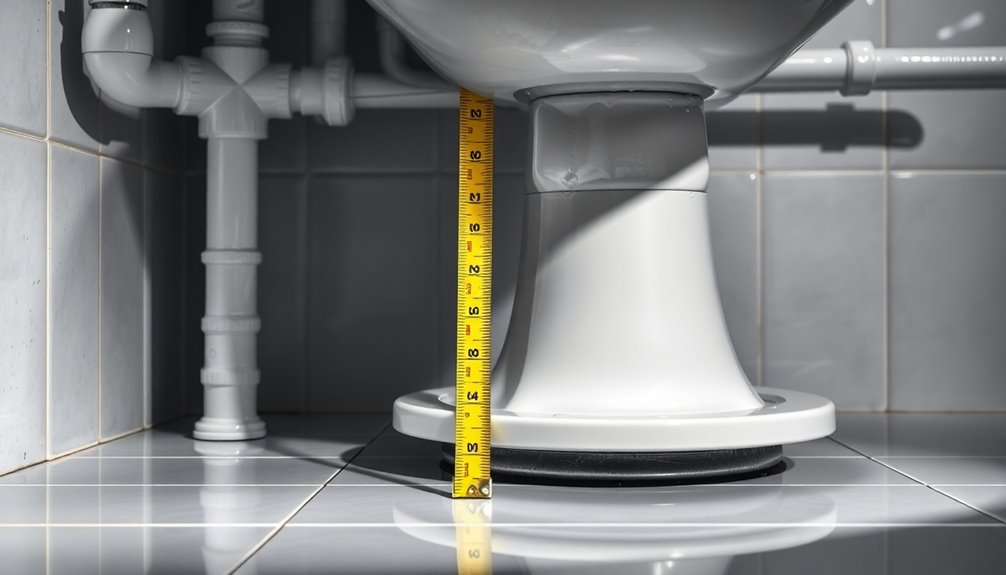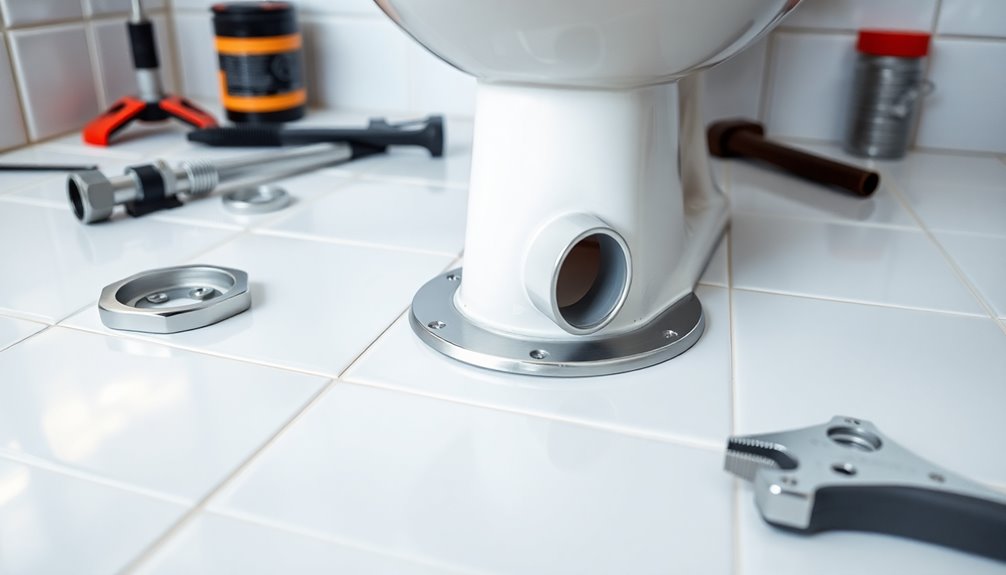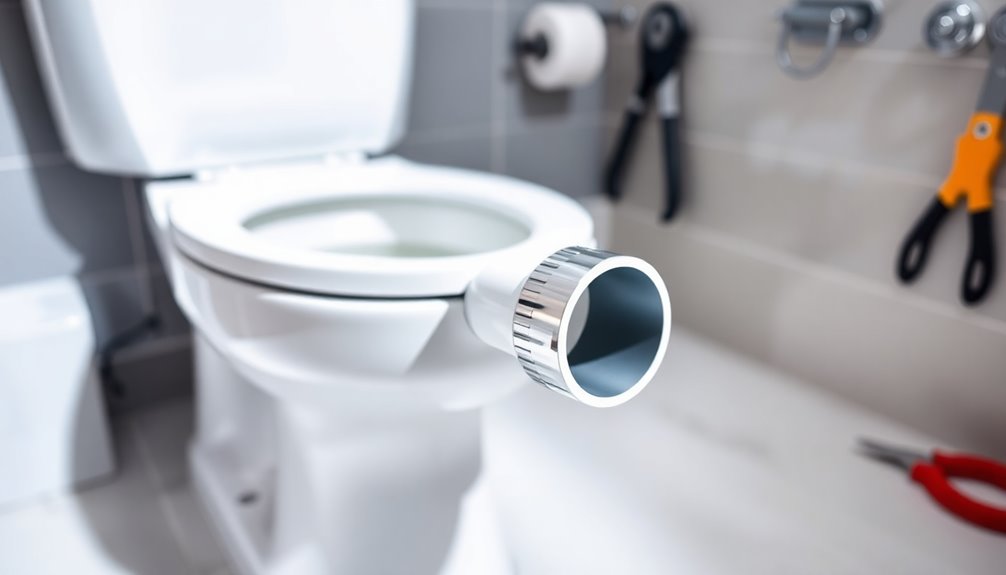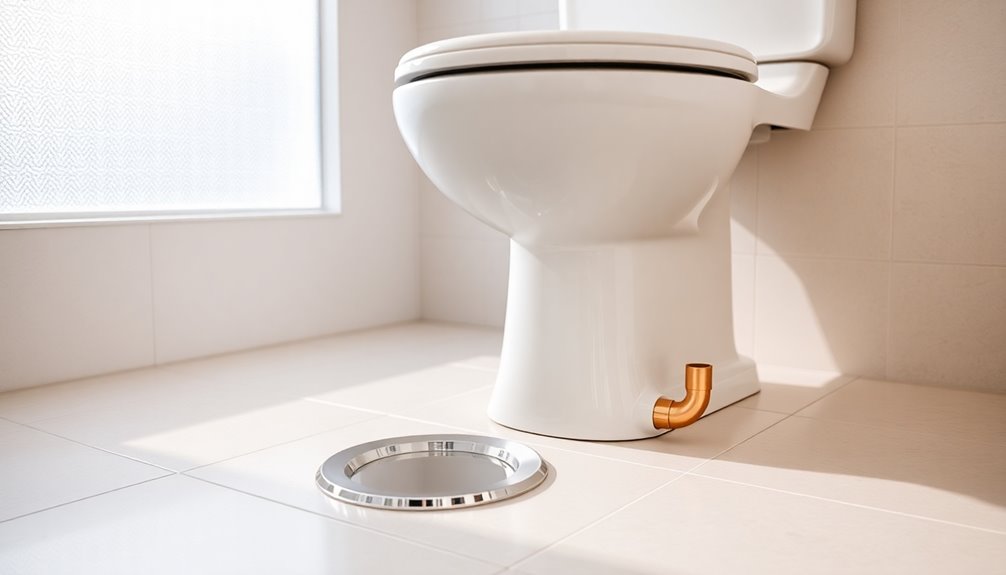The first 90-degree bend should be no more than 12 inches from the toilet flange. This distance is vital for maintaining good drainage and preventing clogs that can lead to expensive plumbing issues. Ideally, you'll want to install the elbow 6 to 12 inches away, using long sweep fittings when possible. This helps promote smoother waste flow and reduces back pressure. By following these guidelines, you can save on potential plumbing repairs. If you're looking for more tips and best practices for plumbing installations, there are plenty of resources available to enhance your project's success.
Importance of Proper Distance
When it comes to plumbing, the distance between a toilet flange and the first fitting, like a 90-degree elbow, plays an essential role in guaranteeing proper drainage. Ideally, you shouldn't exceed 10 feet from the flange to the fitting. This distance helps maintain efficient flow, preventing clogs that can lead to costly repairs and headaches. Regular reviews of your plumbing setup can help identify potential issues before they become significant problems. In addition, utilizing tools like expense management apps can assist in budgeting for plumbing projects effectively.
Local plumbing codes, such as those in Florida, emphasize keeping this distance as short as possible to uphold the trap seal and prevent siphoning issues. Make certain to take into account the type of piping used, as different sizes or materials might necessitate closer distances to comply with regulations.
When you push the limits and exceed that 10-foot mark, additional venting may be required to guarantee proper drainage and prevent potential code violations. Furthermore, the vertical drop must be factored in, as exceeding theoretical limits can lead to serious drainage problems. Additionally, understanding the importance of expense tracking tools can help ensure that any plumbing projects are budgeted effectively.
Plumbing Code Guidelines
Understanding the importance of maintaining the right distance from the toilet flange leads us to plumbing code guidelines, which provide specific recommendations for these measurements.
Most plumbing codes suggest that the distance from the toilet flange to the first 90-degree bend in the drain line shouldn't exceed 10 feet. This guarantees proper drainage and helps prevent clogging. Additionally, some areas specify a maximum vertical drop of 24 inches from the flange to that first bend, promoting efficient waste flow. Implementing effective automated investment management can further enhance your financial planning by ensuring you save adequately for unexpected plumbing repairs. Having a clear understanding of financial reporting can also aid in budgeting for such expenses.
To comply with drainage efficiency standards, the Uniform Plumbing Code (UPC) recommends keeping the distance to the first horizontal alteration within 3 feet. For residential installations, placing the first 90-degree fitting within 6 feet of the toilet flange is ideal for maximum venting and drainage performance.
Don't forget, local amendments to plumbing codes may differ, so it's crucial to consult local regulations to verify compliance with specific distance requirements. Utilizing effective expense tracking tools can also help save on costs associated with plumbing repairs and maintenance.
Keeping these guidelines in your bag of tricks will help you avoid future plumbing headaches and maintain a smoothly functioning system.
Effects of Incorrect Placement

If you place a 90-degree fitting too close to the toilet flange, you might face improper drainage and increased clogging risks.
This misalignment can also compromise the seal's integrity, leading to leaks that could damage your flooring. Maintaining proper plumbing alignment is crucial for optimal performance and longevity of your system. Additionally, implementing clear payment terms can help ensure that any plumbing-related expenses are settled on time, preventing financial strain. Understanding these effects is essential for maintaining a functional plumbing system. Additionally, addressing plumbing issues promptly can help prevent increased financial strain caused by repairs and water damage.
Improper Drainage Issues
Proper placement of a 90-degree fitting is crucial for maintaining efficient drainage in your plumbing system. If you install the fitting too close to the toilet flange, it can create significant drainage issues.
Here are some effects of improper placement:
- Increased resistance in the drainage system, slowing down waste flow.
- Risk of trap siphoning, allowing sewer gases to escape into your bathroom.
- Creation of a "dead zone" where waste can accumulate, increasing the chances of backups.
- Compromise of plumbing codes, especially if the distance to a vent exceeds six feet.
- Difficulty in achieving ideal elbow angles, which can further disrupt drainage efficiency.
Keeping the recommended distance of at least 12 inches from the toilet flange helps prevent these problems.
When you don't consider this distance, you jeopardize the entire plumbing system's functionality.
Increased Clogging Risks
Installing a 90-degree fitting too close to the toilet flange can greatly increase the risk of clogs in your plumbing system. When these fittings are placed too near the flange, they restrict flow and disrupt the siphoning action of the toilet. This can lead to insufficient drainage velocity, causing waste buildup and ultimately, clogs.
To minimize these issues, plumbing codes recommend positioning 90-degree bends at least 12 inches from the toilet flange.
Incorporating gradual angles instead of sharp bends is an essential clogging prevention strategy. This practice reduces turbulence, allowing waste to flow more freely through the pipes. Additionally, maintaining the proper distance from the flange helps preserve the trap seal, important for preventing odors and ensuring efficient drainage.
To avoid toilet installation issues, consider these plumbing maintenance tips: regularly inspect your plumbing system for signs of clogs, and make adjustments to your fittings when necessary.
Compromised Seal Integrity
Positioning a 90-degree fitting too close to a toilet flange can severely compromise the integrity of the seal, leading to a host of plumbing problems.
When you neglect the required distance, you risk disrupting proper drainage, increasing the likelihood of clogs, and causing leaks that can result in costly repairs.
Here are some critical considerations to keep in mind:
- Regular flange inspections are essential to guarantee compliance with plumbing codes.
- Maintain a minimum distance of 12 inches from the toilet flange to the first fitting.
- Use appropriate plumbing seal materials to enhance durability and reliability.
- Implement seal maintenance tips to prevent deterioration over time.
- Be aware of pressure changes that can disrupt the trap seal, allowing sewer gases into your home.
Types of Toilet Flanges
There are several types of toilet flanges available, each made from different materials that cater to various plumbing needs. A flange materials comparison reveals that metal, PVC, cast iron, lead bends, and copper flanges all serve unique purposes.
Metal flanges are often paired with PVC inserts, creating a durable connection for modern installations. Meanwhile, PVC flanges dominate contemporary plumbing systems due to their corrosion resistance and straightforward installation techniques.
In older homes, you might still encounter lead bends, which require brass rings for added strength and durability. This historical flange evolution shows how materials and designs have adapted over time to meet the changing demands of plumbing. Understanding the importance of proper installation is vital, as the flange must sit on top of the finished floor to maintain a watertight and gas-tight connection.
When selecting a flange, consider your specific plumbing conditions and choose the appropriate type to guarantee a reliable seal. Proper installation is vital, as the flange must sit on top of the finished floor to maintain a watertight and gas-tight connection.
Understanding these various types of toilet flanges will help you make informed decisions for your plumbing projects, saving you time and potential headaches in the long run.
Installation Best Practices

When it comes to toilet installation, adhering to best practices can make a significant difference in performance and longevity. By following proper toilet installation techniques, you can guarantee peak drainage flow and prevent future issues.
Here are some key points to keep in mind:
- Keep the distance from the toilet flange to the first 90-degree bend to no more than 12 inches for effective drainage flow optimization.
- Use long sweep 90-degree fittings instead of standard ones to promote a smoother shift and reduce the risk of clogs.
- Confirm the installation complies with local plumbing codes, which may dictate a maximum horizontal distance of 3 meters (10 feet) from the flange to the vent stack.
- Conduct regular inspections of the installation area to verify that the fitting's distance and angle meet plumbing regulations.
- Choose the right plumbing fitting selection to enhance waste removal and minimize sewage gas backup.
Common Installation Issues
When installing a 90-degree bend near a toilet flange, you need to take into account the flange height, as it can greatly impact drainage.
You might also face challenges with pipe alignment, which can lead to leaks or backups if not addressed properly.
Plus, don't forget about code compliance; it guarantees your installation meets necessary regulations for safe operation.
Flange Height Considerations
Making sure the toilet flange is set at the correct height is essential for a successful installation. When flanges are too low, often due to subfloor thickness, you risk creating a host of problems that can affect the functionality of your toilet.
The flange should be installed flush with the finished floor to guarantee proper sealing and alignment. Here are some common installation issues to watch out for:
- Flange materials: Different materials can affect the durability and height of your flange.
- Flange types: Choose the right type for your toilet and floor configuration.
- Flange adjustments: Be prepared to make adjustments if the flange isn't at the right height.
- Water leakage: Low flanges can lead to leaks and costly repairs.
- Code compliance: Verify your installation meets local plumbing codes to avoid future complications.
Pipe Alignment Challenges
Proper pipe alignment is vital for a successful toilet installation. You need to pay attention to the positioning of the 90-degree elbow, ideally placing it no closer than 12 inches from the toilet flange. This distance minimizes potential clogs and guarantees smooth drainage.
If you install the elbow too close, it can create resistance, leading to slower drainage and increased risk of backups.
To tackle pipe misalignment challenges, consider using effective pipe misalignment solutions. If you have multiple 90-degree bends, space them out appropriately to avoid sharp turns. Utilizing elbow fitting techniques can help maintain the right flow direction without disrupting waste movement.
Additionally, always make drainage slope adjustments to maintain at least a 1/4 inch drop per foot. This is essential to prevent solids from getting trapped in the pipes.
Code Compliance Necessities
Addressing pipe alignment challenges is just the beginning.
Guaranteeing code compliance during your toilet flange installation is vital. Failing to adhere to local regulations can lead to significant code enforcement implications, resulting in costly repairs and potential fines.
Here's what you need to keep in mind:
- The maximum horizontal distance from the toilet flange to the 90-degree fitting shouldn't exceed 10 feet.
- The vertical distance should stay within 24 inches to prevent trap seal loss.
- Proper placement of the 90-degree fitting is essential; too close can hinder drainage.
- Familiarize yourself with your local regulations comparison to avoid future plumbing issues.
- Following the inspection procedures overview can help guarantee that your installation meets all necessary requirements.
Understanding these compliance necessities guarantees that your installation is effective and reduces the risk of plumbing problems.
Always prioritize local codes to maintain system efficiency and avoid headaches down the line.
Optimal Elbow Placement

When it comes to ideal elbow placement for a toilet flange, you'll want to position the 90-degree elbow between 6 to 12 inches away. This distance is vital for maintaining proper flow and minimizing potential clogs.
If you place the elbow too close to the flange, you risk back pressure, which can hinder drain efficiency and lead to frustrating plumbing issues.
Remember that local plumbing codes often recommend specific distances for a reason: effective waste removal. It's important to account for the total length of the drainpipe when positioning the elbow. Excessive bends can increase friction loss, making it harder for waste to flow smoothly.
Consider using different elbow types, like a longer sweep elbow, instead of a standard 90-degree elbow. This can greatly improve flow dynamics, reducing the possibility of blockages in your plumbing system.
Tools for Accurate Measurement
Accurate measurement is vital in achieving the right placement for your 90-degree bend. To guarantee you maintain the essential minimum distance of 12 inches from the toilet flange, you need to employ effective measurement techniques and select the right tools.
Here are some tools that can help with distance verification:
- Tape Measure: A standard tool for measuring distances, guaranteeing you get that 12-inch requirement.
- Laser Distance Measurer: Offers precise readings and minimizes errors, especially in tight spaces.
- Marker or Chalk: Use this to mark the location of your 90-degree bend on the floor as a visual reference.
- Level: Guarantees your horizontal pipe run is straight, which is essential for maintaining proper flow.
- Pipe Support Brackets: These can secure your plumbing lines at the correct distance from the flange, preventing sagging.
Troubleshooting Plumbing Problems

Troubleshooting plumbing problems can save you time and money, especially if you've noticed issues with your toilet's drainage.
Start by checking the placement of the 90-degree fitting; it should be no more than 12 inches away from the toilet flange. If it's too far, you may experience clogs due to improper drainage solutions. Additionally, confirm that the vertical drop from the flange doesn't exceed local plumbing codes, which typically limit it to 24 to 36 inches.
Don't overlook venting strategies either. The distance between the toilet and the vent should comply with local regulations to prevent siphoning issues that can lead to slow drainage.
If you're facing frequent backups, consider replacing 90-degree fittings with 45-degree fittings where possible. This small change can considerably reduce resistance in the drain line, enhancing flow and minimizing the risk of obstructions.
Lastly, always familiarize yourself with local plumbing codes regarding installation techniques. Each region may have specific requirements, and adhering to them is essential for effective troubleshooting and long-term plumbing health.
Professional Advice and Resources
For successful toilet installation and plumbing maintenance, seeking professional advice is vital. Many homeowners fall for plumbing myths that can lead to costly mistakes. Understanding proper installation techniques and flange materials is important for avoiding future issues.
Here are five key points to keep in mind when consulting a professional:
- Distance Matters: The maximum distance from a toilet flange to the first fitting should generally not exceed 10 feet.
- Elbow Placement: Maintain at least 12 inches between the flange and any 90-degree elbow to minimize clogging.
- Height Alignment: Verify the flange is level with the finished floor for proper pipe alignment.
- Local Codes: Always check local plumbing codes, as they may have specific requirements regarding distances and angles.
- Fittings Choice: Where space allows, opt for a 45-degree fitting instead of a 90-degree to enhance flow efficiency.
Conclusion
In summary, keeping the right distance for a 90-degree elbow from the toilet flange is essential for smooth plumbing. You might think it's not a big deal, but improper placement can lead to blockages and costly repairs down the line. By following plumbing code guidelines and best practices, you can save money and frustration. Remember, a little attention to detail now can prevent bigger problems later. So, don't overlook this important step in your installation!



